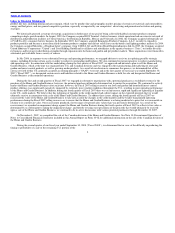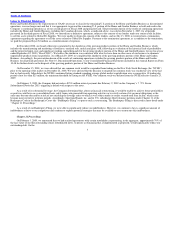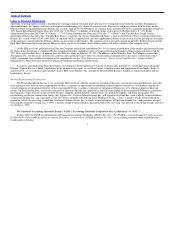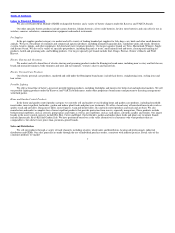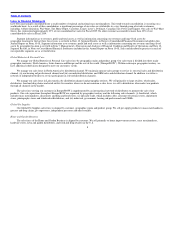Rayovac 2009 Annual Report Download - page 14
Download and view the complete annual report
Please find page 14 of the 2009 Rayovac annual report below. You can navigate through the pages in the report by either clicking on the pages listed below, or by using the keyword search tool below to find specific information within the annual report.
Table of Contents
Index to Financial Statements
Products we sell in the household insect control product category through the Home and Garden Business, face competition from S.C. Johnson &
Son, Inc. (“S.C. Johnson”), which markets insecticide and repellent products under the Raid and OFF! brands; Scotts Company, which markets household
insect control products under the Ortho brand; and Henkel KGaA, which markets insect control products under the Combat brand.
Some of our major competitors have greater resources and greater overall market share than we do. They have committed significant resources to
protect their market shares or to capture market share from us in the past and may continue to do so in the future. In some key product lines, our competitors
may have lower production costs and higher profit margins than we do, which may enable them to compete more aggressively in advertising and in offering
retail discounts and other promotional incentives to retailers, distributors, wholesalers and, ultimately, consumers.
Seasonality
On a consolidated basis our financial results are approximately equally weighted between quarters, however, sales of certain product categories tend
to be seasonal. Sales in the consumer battery, electric shaving and grooming and electric personal care product categories, particularly in North America,
tend to be concentrated in the December holiday season (Spectrum’s first fiscal quarter). Demand for pet supplies products remains fairly constant
throughout the year. Demand for home and garden control products sold though the Home and Garden Business typically peaks during the first six months
of the calendar year (Spectrum’s second and third fiscal quarters). For a more detailed discussion of the seasonality of our product sales, see Item 7.
Management’s Discussion and Analysis of Financial Condition and Results of Operations—“Seasonal Product Sales.”
Governmental Regulations and Environmental Matters
Due to the nature of our operations, our facilities are subject to a broad range of federal, state, local and foreign legal and regulatory provisions
relating to the environment, including those regulating the discharge of materials into the environment, the handling and disposal of solid and hazardous
substances and wastes and the remediation of contamination associated with the releases of hazardous substances at our facilities. We believe that
compliance with the federal, state, local and foreign laws and regulations to which we are subject will not have a material effect upon our capital
expenditures, financial condition, earnings or competitive position.
From time to time, we have been required to address the effect of historic activities on the environmental condition of our properties. We have not
conducted invasive testing at all facilities to identify all potential environmental liability risks. Given the age of our facilities and the nature of our
operations, it is possible that material liabilities may arise in the future in connection with our current or former facilities. If previously unknown
contamination of property underlying or in the vicinity of our manufacturing facilities is discovered, we could incur material unforeseen expenses, which
could have a material adverse effect on our financial condition, capital expenditures, earnings and competitive position. Although we are currently engaged
in investigative or remedial projects at some of our facilities, we do not expect that such projects, taking into account established accruals, will cause us to
incur expenditures that are material to our business or financial condition; however, it is possible that our future liability could be material.
We have been, and in the future may be, subject to proceedings related to our disposal of industrial and hazardous material at off−site disposal
locations or similar disposals made by other parties for which we are held responsible as a result of our relationships with such other parties. In the U.S.,
these proceedings are under the Federal Comprehensive Environmental Response, Compensation and Liability Act of 1980 (“CERCLA”) or similar state
laws that hold persons who “arranged for” the disposal or treatment of such substances strictly liable for costs incurred in responding to the release or
threatened release of hazardous substances from such sites, regardless of fault or the lawfulness of the original disposal. Liability under CERCLA is
typically joint and several, meaning that a liable party may be responsible for all costs incurred in investigating and remediating contamination at a site. As a
practical matter, liability at CERCLA sites is shared by all of the viable responsible
11



